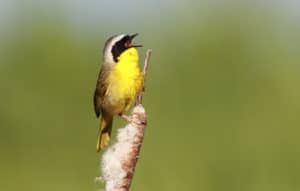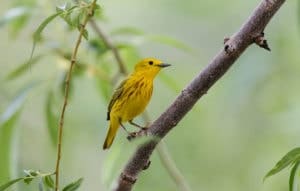Red-winged Blackbird
Pumpkin Eeeeeeeater
A classic wetland bird, the Red-winged Blackbird’s trill is distinct and musical. Each spring, male Red-winged Blackbirds can be found perched on the tops reeds across North America, singing its iconic Pumpkin Eeeeeeater! Only males sing this particular song, which oftentimes lands him several mates – in some cases up to 15. Females sing a less melodic song in response: a short series of chit or check sounds.

Common Yellowthroat
Witchety, Witchety, Witchety
Common Yellowthroats make their home in dense thickets and fields, anywhere from grasslands to marshes to pine forests. Their song is heard most often in the summer, when they’re protecting their territory and searching for their mate. During their peak, Common Yellowthroats sing as many as 125 songs per hour! So if you’re in Yellowthroat territory, there’s a good chance you’ll hear male and females singing Witchety-Witchety-Witchety.

Brown Creeper
Trees, Trees, Beautiful Trees
Brown Creepers are really good at blending into their environment. These small brown birds are usually found in forested areas, creeping their way up tree trunks as they look for insects in the grooves of bark. Keep your eyes attuned to the trunks of trees for movement, and your ears open for their call that (fittingly) sounds just like Trees, Trees, Beautiful Trees! I like to think of it as an homage to the place they call home.

Yellow Warbler
Sweet Sweet Sweet, I’m So Sweet
There’s something particularly sweet about the arrival of migratory songbirds in springtime, especially colorful species like the Yellow Warbler. Yellow Warblers start showing up in the Portland-area in April, and these birds are hard to miss with their bright yellow plumage and harmonious song. One of the most commonly heard birds in the springtime, the male’s song is a series of six to ten whistle notes, often thought to sound just like Sweet, Sweet, I’m So Sweet!

American Robin
Cheerily, Cheer Up, Cheer Up, Cheerily, Cheer Up
One of the first harbingers of spring, the sights and sounds of the American Robin bring with it a sense of joy and relief from the cold winter months. Although you may notice robins much more during the spring, these birds actually winter in the same range. But come spring, their cheery song of ten or so clear whistles is heard far and wide: Cheerily, Cheer Up, Cheer Up, Cheerily, Cheer Up.

BONUS
Barred Owl
Who Cooks for You? Who Cooks for You All?
Barred Owls aren’t technically song birds, but their call is melodious, song-like, and one worth looking out for. Because these birds are more active at night, it can be tricky to spot them during daylight hours as they quietly roost in their densely treed habitat. Occasionally during the day but more frequently at night, you’ll hear their call fill the skies: Who Cooks for You? Who Cooks for You All?




